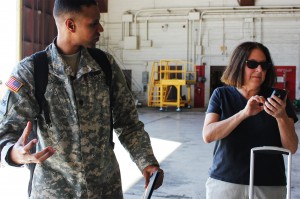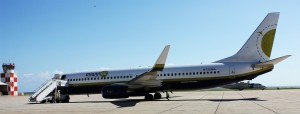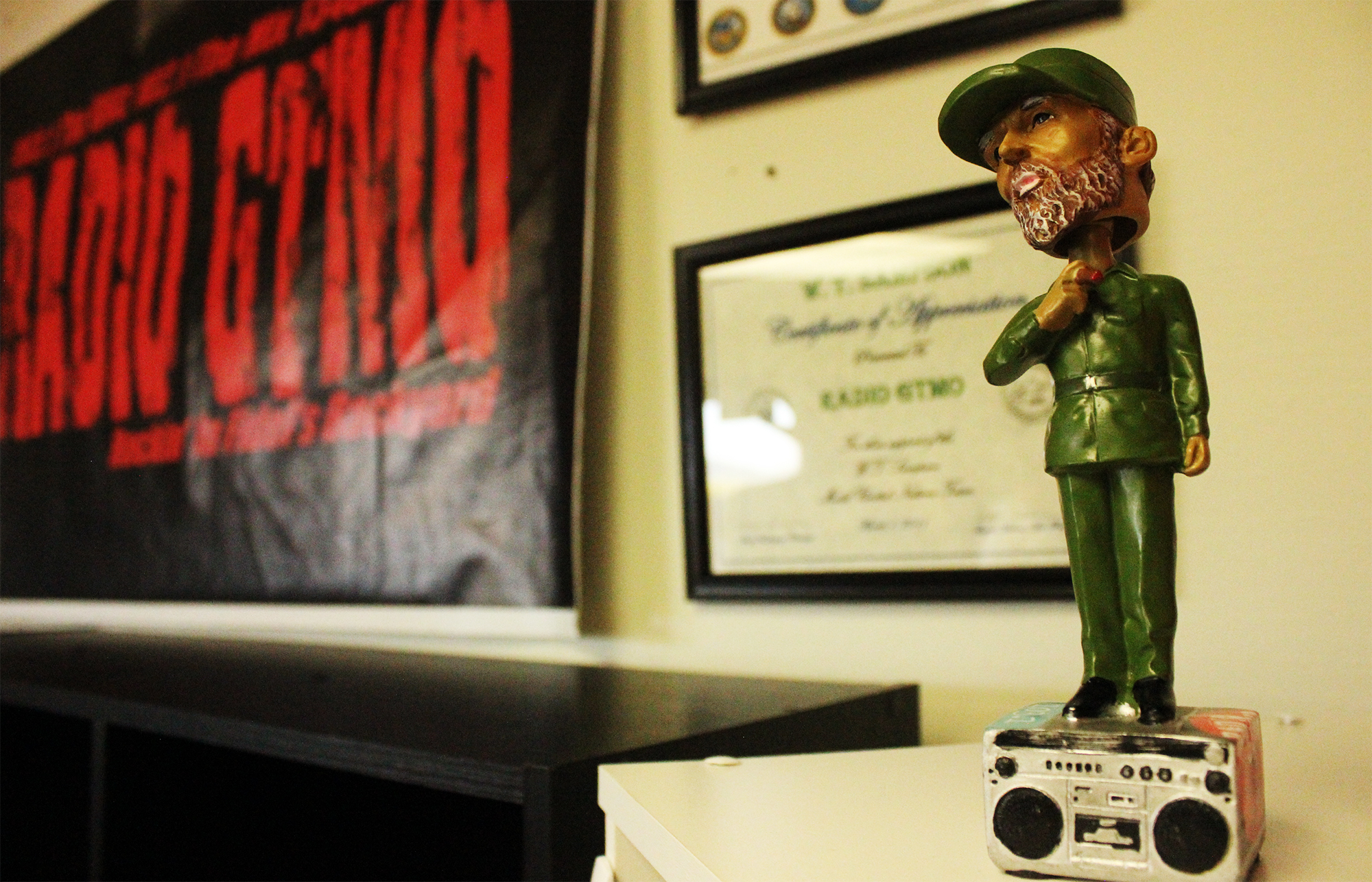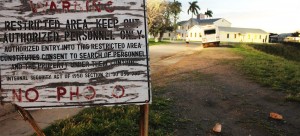Follow @medillonthehill, @HayatNorimine and #HadiCase for immediate updates on Guantanamo Bay travels and the case.
Day 4: Shoots and free time
With court wrapping up early, more free time for us to explore areas of Guantanamo Bay that have been on our list since arrival. But more time also means more eyes on us. Military personnel at this point have seen us and grown wary of our equipment. And Operational Security has cracked down on our multimedia.
We’ve done our best to follow the rules and seek permission whenever we had the chance. That didn’t stop OPSEC from walking into our media tent at 9 a.m. Wednesday, saying we needed to show them all of our photos again from day 1, both published and unpublished. The procedure in place was to check our photos and video with OPSEC every night. My photos from Tuesday had been checked by two people and already uploaded.
Public affairs officers came to our tent an hour before we were supposed to leave for our scheduled tour of Camp X-Ray, the first detention facility, which once housed Haitians seeking asylum. We were told if there were problems with my pictures, we might not make it to the tour.
It didn’t end up being an issue. While the timing was questionable, OPSEC didn’t stop us from taking the tour even though the security team didn’t have enough time to go through Merrill D’Arezzo’s video.
They had concerns with some unpublished photos that I didn’t care about, and they were deleted. They also had a problem with one photo that had already been cleared by two people previously and published on my personal blog. This one:
And I was very attached to this photo. I picked my battles, and I thought it was worth fighting for. It showed a little bit of everything I had wanted without crossing the line — the climate, the stringent restrictions, the surreal residential areas. I kept it.
When personnel inspected the photo, one said it was because of the sign that clearly said “no photo.” The other said I could keep the sign but not the building in the background. The first time around, I had heard it was fine because someone had escorted me there at the time. That person was present as I took photos. And the building is far enough away.
Here are some of the rules:
-No photos during drives.
-No photos of the coastline.
-No photos of the faces of anyone on the Joint Task Force, even if a member is OK with it. This includes almost everyone who works or lives on the base. Photos of their backs or their uniforms are fine if they’re unidentifiable.
-No photos of the physical facilities.
Everyone does their best. And the military has a wariness of the media that, at times, is warranted. I respect the rules in place, but I also know my rights as a reporter. I’ve learned the rules so that when someone is wrong, I can respectfully challenge a decision.
Be friendly and respectful, and you can still get some pretty cool photos.

Operated by the military, Radio GTMO is the broadcast station with the slogan, “Rockin’ it in Fidel’s backyard.” The Fidel Castro bobblehead is one of several popular souvenirs at its headquarters. Hayat Norimine / Medill Reports
DAY 3: Decisions and postponements
You never know what to expect.
We came into the courtroom Tuesday assuming a quick hearing that would lead to postponing the motion on female guards to Wednesday. To quote the judge, Capt. J.K. Waits, the hearings have moved backward. Now there is a question of the defense team’s access to witnesses.
Waits ruled that the defense attorneys did not have adequate time to review evidence and interview witnesses. He was especially harsh on Lt. Col. David Long, prosecutor for the U.S. government, saying the government did not grant the defense lawyers the access they were entitled to. “That is the most basic of due process,” Waits said.
But Gen. Mark Martins, chief prosecutor at Guantanamo Bay, said he’s comfortable with the system in place. It ensures proper security measures, he said, by making sure there’s access to classified government information only when it’s relevant to the case.
“I would push back on any notion that individuals in the proceeding don’t have access [to witnesses and evidence],” Martins said. “I believe the proceeding is well under control.”
Waits said the government’s failure to provide the defense access to evidence and witnesses “belies” its claim that the hearings should move quickly and could have an immediate impact on security measures. Waits told Long he needs to be more specific about how the motion would impact the facility’s security.
Later, Long said, “I hope to have the opportunity to do that.”
“You have the opportunity to do that right now,” Waits responded.
Waits also decided to deny the defense’s request to dismiss all charges. That wasn’t too much of a surprise.
DAY 2: Reporting in the courtroom
A few points on reporting in a court in Guantanamo Bay:
1. No electronics allowed. It’s back to the old school reporting for us, with pen and paper. Veteran Guantanamo Bay journalist Carol Rosenberg chooses to stay in the media room, where she can watch a projection of the hearings and live-tweet them.

Army Lt. Col. Myles Caggins, spokesman and media sponsor, speaks with Carol Rosenberg, who’s been covering Guantanamo Bay for 13 years. Hayat Norimine / Medill Reports
2. It’s very controlled. We stand up when we’re told to stand up, we talk only when we’re allowed, we’re assigned seats and expected to remain in them. Soldiers pick us up from the media room and drive us directly to the hearings, and we’re generally walking with an escort at any given time. There are three security checks when entering the courtroom. Guards check ID badges (given to us on arrival), write down the times we enter (and leave), and,of course, go through our bags. A soldier seemed slightly alarmed at the camera batteries I happened to be carrying. There was no camera.
3. A glass wall separates the observers from the courtroom, and there’s a 40-second delay of the broadcast. That means we see what’s going on in the courtroom before we hear what’s being said.
Sometimes it’s actually helpful; I can prepare to take thorough notes when I see lawyers at the podium. Mostly, it’s bewildering — soldiers enter our room yelling, “All rise!” before we even hear the judge’s last words. I nearly had a heart attack several times.
4. Detainees had a little more freedom than what I had expected. Al-Iraqi was able to wear his traditional garb of all-white turban and dishdasha, a one-piece loose Muslim male garb flowing down to the ankles. On the floor, chains were attached to chairs on the left, but are only used when the judge believes restraint is necessary.
Al-Iraqi was unrestrained. In the event restraints were called for, the chains on the floor to the left would be used, presumably out of sight of the jury sitting on the right. That way seeing the restraint wouldn’t affect any of its decisions.
DAY 2: T-minus one hour until the first hearing
Here’s the background for the judicial proceeding: defendant Abd al Hadi al-Iraqi was a commander in al-Qaida and allegedly committed war crimes against the U.S. in Afghanistan. The defense is arguing al-Iraqi was in the military and therefore is a prisoner of war.
The first hearing will be determining his status and whether he classifies as a POW.
We’re first headed to the courtroom, where only pen and paper are allowed.
DAY 1: T-minus 16 hours until the first hearing
We left Andrews Air Force Base at 10 a.m. and arrived in Guantanamo Bay at about 1:30 in the morning — two Medill reporters, myself and Merrill D’Arezzo. Andrews Air Force Base, located in southern Maryland and home to Air Force One, was not easy to navigate at 5:30 a.m. Predictably, we first went to the wrong gate and when we finally got to where we needed to be, we couldn’t get in without military ID. Problem? We were too early and stood in the cold outside until a staff member took pity and let us in. I guess there are some benefits to arriving on time, but no earlier.

The flight from Andrews Air Force Base to Guantanamo Bay took about three and a half hours. Hayat Norimine / Medill Reports
We had flown aboard a Miami Airlines plane filled with military personnel, lawyers and judges, and about 15 civilians. On the plane we were sorted into three main groups: the judges sit up front; military and lawyers in the middle; media, NGOs and students in rows 27 and on down.

Military personnel, lawyers, NGO representatives, media and students lined up for a security check after landing in Guantanamo Bay. Hayat Norimine / Medill Reports
We were segregated further when we arrived. After grabbing our checked luggage for a brief ferry ride, we headed for our quarters in Guantanamo’s tent city. It was 88 degrees Fahrenheit.

Caggins gives us a brief description of the landscape we see crossing Guantanamo Bay on the ferry. Hayat Norimine / Medill Reports
These tents are a two-minute walk from the media room, which has the only decent access to the Internet. The sleeping quarters are about 20-foot-wide-by-100-foot-long beige domes built primarily of plywood. Each room was separated by wooden boards and a brown curtain for privacy from the hallway. I entered mine to find a plastic bag holding four towels, sheets, pillow cases and a blanket. Besides the twin-sized bed, three other wooden furniture pieces that created a minimalist but cozy atmosphere. Or at least, it would’ve been cozy — the intense air conditioning to ward off iguanas and banana rats made me a little stiff.














